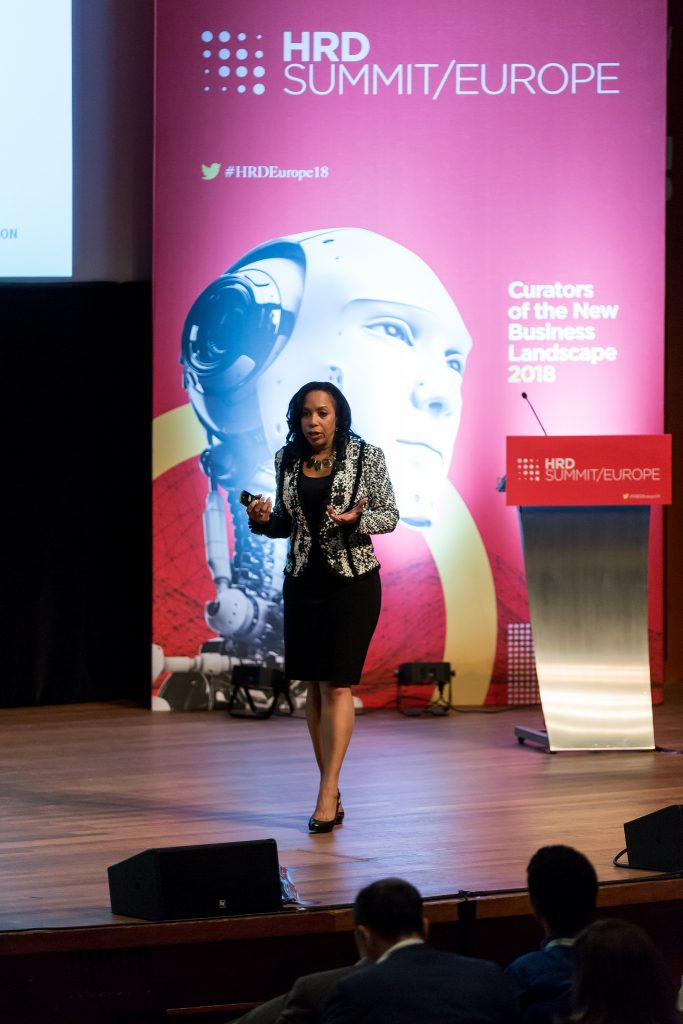Building an inclusive culture at Johnson & Johnson
- 6 Min Read
Chief Diversity Officer at Johnson & Johnson, Wanda Hope was the keynote at the recent HRD Summit/Europe, she spoke about the importance of building inclusive cultures within organisations.
- Author: Emily Sexton-Brown
- Date published: Jul 23, 2018
- Categories

Family values
“The most valuble possession in my family is a roll of toilet paper,” Wanda opened her talk.
She then explained that her mother was a black American student in the 1960s. At that time, her mother was actively involved in equal rights as black people were not allowed to have lunch, use the same bars or even toilets as white people, an activist movement grew which resulted in Hope’s mother and many other students to get arrested for what they believed in.

Whilst Hope’s mother was held in jail she wrote her story on the back of a piece of toilet paper, which explained her want and need for equality and human rights. Hope said her family value this possession highly, even to this day.
“These values have shaped who I am today – the fight for equality and fairness is just as important today as it ever was.”
The ever-changing workforce
After this poignant start to her talk she then explained that the future of the workplace is changing, “Our workforce is going to continue to look different, be it skin, age, or location where they are based,” she explained.
Hope questioned, why aren’t we acknowledging diversity within our workplaces? Don’t we want our workplaces to mirror the markets we represent and sell to?
“How can we connect better with multicultural markets? Those who don’t figure it out, won’t be around very long!”
What with our population stretching to over 9 billion worldwide, the aging population is reaching 1.5 billion who we need to consider and cater for within the workplace. The visibility of LGBT employees are becoming ever more present, and feel that they are more able to bring their entire selves to work which should be actively encouraged. Hope reflected, “In the US where I’m based, the majority is now becoming the minority.” We are seeing such a rich and diverse workforce ever emerge.
Diversity and data
Hope then cited a McKinsey report looking at diversity across organisations. They assessed thousands of companies, and discovered that the companies in the top quartile of gender diversity were much more likely to outperform their peers. Deloitte’s research also concluded that inclusive cultures are three times likely to perform higher than their competitors.
Hope spoke about how she spent the first 20 years of her career within sales and marketing and therefore ROI was a big driver behind her key decision making. “Data speaks to me, there is a real bottom line – we need to figure out how to get this right!”
“How can we connect better with multicultural markets? Those who don’t figure it out, won’t be around very long!” Wanda said.
Johnson & Johnson have always been an exceptionally diverse organisation, since it formed 130 years ago. Hope shared that half of Johnson & Johnson’s first 15 employees were women and the commitment to diversity has been present ever since.
“These values have shaped who I am today – the fight for equality and fairness is just as important today as it ever was.”
When Hope joined as Chief Diversity Officer she recalls that the diversity and inclusion agenda was well-meaning and strong, however, people struggled to pair actions with the outcome. They decided a new company-wide approach was needed.
“We decided to build a strategic plan and we did a situation assessment both internal and external – connected with thousands of employees globally. We carried out one-to-one interviews and in-depth focus groups. We wanted transparency and insights, 7000 employees responded to survey giving us personal development and cultural points of view,” Hope said.
From the insights gather, Johnson & Johnson decided to focus on these three key areas;
- Advancing culture
- Building a more diverse workforce
- Enhance business (performance and reputation)
“This was a strategy co-created with employees all over the world. The strategy is so inclusive and means something to everyone all around the world, which is exactly what we wanted to create.”
One thing Hope and the team noticed when they questioned employees about defining diversity and inclusion, diversity had different meanings but inclusion meant the same to every single person, the feeling of belonging.
Unconscious bias
Hope spoke about the need to address unconscious bias at Johnson & Johnson, it’s something that everyone needs to be educated about. 95% of ourleaders go through detailed e-learning on this topic and we also held sessions with a professor from Harvard University to explain further.
“We want our global strategy to be locally relevant.”
The way job descriptions are written can unknowingly set a prejudice, for instance, Hope said that the words ‘ninja’ and ‘superstar’ aren’t as appealing to women as they are to men. Hope spoke about Johnson & Johnson trialling the company Textio that specifically highlights words more biased towards men or women, she was pleased with the outcome and thought it was highly successful and has made changes towards the way they write their job descriptions.
Local culture
“We want our global strategy to be locally relevant,” she said.
Hope then spoke about an example of what has happened within their Japanese operation, the cultural expectations were to work long hours, this needed to change and they developed the ‘switch programme’, which the employees came up with together. At a reasonable time the building entirely close down and the lights physically switch off. Since this has been introduced women retention has increased and work-life balance is much more present.
Connecting diversity and inclusion to our businesses
Driving real business value is making this sustainable – for example, Hope spoke about their Malaysian market. Listerine, a J&J product contains alcohol like most mouthwash products. In a predominately Muslim culture, this doesn’t work. A forward-thinking and inclusive employee decided to create one that was green tea based which was alcohol-free. It became inclusive and increased the market share by 7%.
“This messaging needs to come from the top and be role modeled, become an LGBT ally, support women in leadership and gender diversity, provide supportive and inclusive working environments for disabled employees. Ensure that you are treating diversity and inclusion as business imperative,” Hope concluded.









